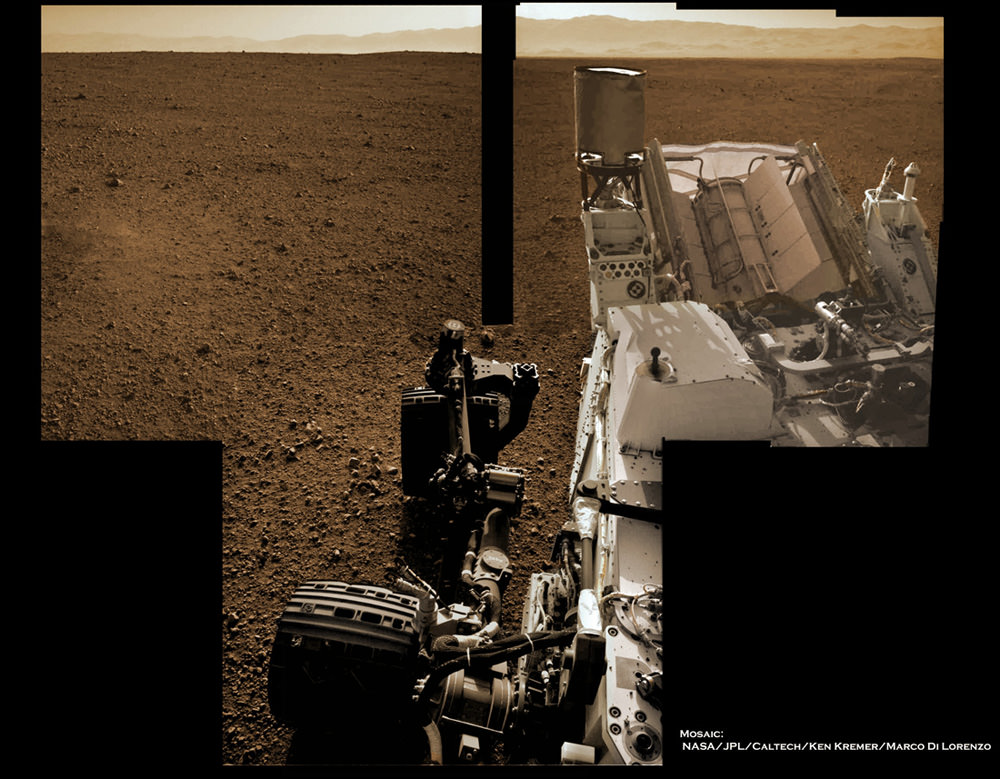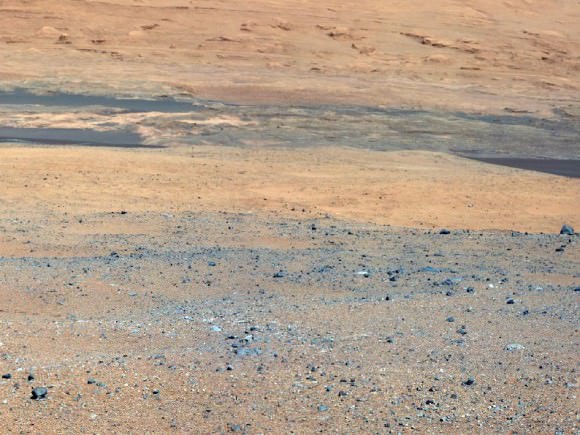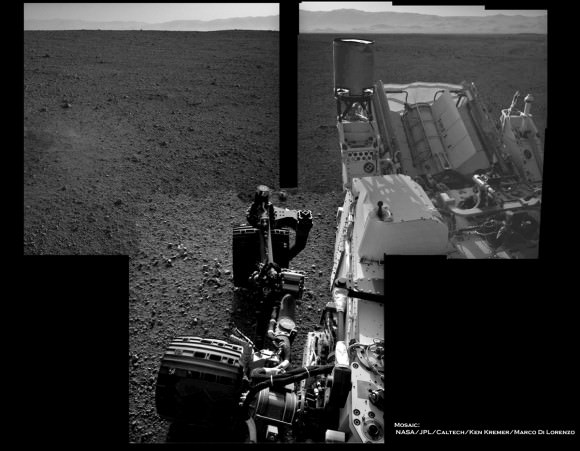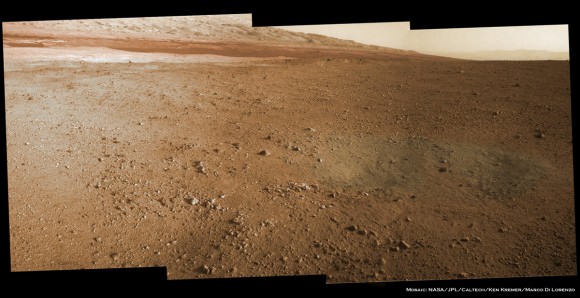Image Caption: Curiosity’s Wheels Set to Rove soon Mars inside Gale Crater after ‘brain transplant’. This colorized mosaic shows Curiosity wheels, nuclear power source and pointy low gain antennea (LGA) in the foreground looking to the eroded northern rim of Gale Crater in the background. The mosaic was assembled from full resolution Navcam images snapped by Curiosity on Sol 2 on Aug. 8. Image stitching and processing by Ken Kremer and Marco Di Lorenzo. see black & white version below. Credit: NASA/JPL-Caltech/Ken Kremer/Marco Di Lorenzo
Curiosity’s weekend “Brain transplant” proceeded perfectly and she’ll be ready to drive across the floor of Gale Crater in about a week, said the projects mission managers at a NASA news briefing on Tuesday, Aug. 14. And the team can’t wait to get Curiosity’s 6 wheels mobile on the heels of a plethora of science successes after just a week on Mars.
Over the past 4 sols, or Martian days, engineers at NASA’s Jet Propulsion Lab (JPL) successfully uploaded the new “R10” flight software that is required to carry out science operations on the Red Planet’s surface and transform the car-sized Curiosity from a landing vehicle into a fully fledged rover.
The step by step flight software transition onto both the primary and backup computers “went off without a hitch”, said mission manager Mike Watkins of JPL at the news briefing. “We are ‘Go’ to continue our checkout activities on Sol 9 (today).”
Watkins added that the electronic checkouts of all the additional science instruments tested so far, including the APXS, DAN and Chemin, has gone well. Actual use tests are still upcoming.
“With the new flight software, we’re now going to test the steering actuators on Sol 13, and then we are going to take it out for a test drive here probably around Sol 15,” said Watkins . “We’re going to do a short drive of a couple of meters and then maybe turn and back up.”
See our rover wheel mosaic above, backdropped by the rim of Gale Crater some 15 miles away.
Image Caption: Curiosity landed within Gale Crater near the center of the landing ellipse. The crater is approximately the size of Connecticut and Rhode Island combined. This oblique view of Gale, and Mount Sharp in the center, is derived from a combination of elevation and imaging data from three Mars orbiters. The view is looking toward the southeast. Mount Sharp rises about 3.4 miles (5.5 kilometers) above the floor of Gale Crater. Credit: NASA/JPL-Caltech/ESA/DLR/FU Berlin/MSSS
Curiosity made an unprecedented pinpoint landing inside Gale Crater using the rocket powered “Sky Crane” descent stage just a week ago on Aug. 5/6 and the team is now eager to get the huge rover rolling across the Martian plains towards the foothills of Mount Sharp, about 6 miles (10 km) away as the Martian crow flies.
“We have a fully healthy rover and payload,” said Ashwin Vasavada, Mars Science Laboratory (MSL) deputy project scientist. “We couldn’t be happier with the success of the mission so far. We’ve never had a vista like this on another planet before.”
“In just a week we’ve done a lot. We’ve taken our 1st stunning panorama of Gale crater with focusable cameras, 1st ever high energy radiation measurement from the surface, the 1st ever movie of a spacecraft landing on another planet and the 1st ground images of an ancient Martian river channel.”
A high priority is to snap high resolution images of all of Mount Sharp, beyond just the base of the 3.4 mile (5.5 km) tall mountain photographed so far and to decide on the best traverse route to get there.
“We will target Mount Sharp directly with the mastcam cameras in the next few days,” said Watkins.
Climbing the layered mountain and exploring the embedded water related clays and sulfate minerals is the ultimate goal of Curiosity’s mission. Scientists are searching for evidence of habitats that could have supported microbial life.
Curiosity will search for the signs of life in the form of organic molecules by scooping up soil and rock samples and sifting them into analytical chemistry labs on the mobile rovers’ deck.
Vasavada said the team is exhaustively discussing which terrain to visit and analyze along the way that will deliver key science results. He expects it will take about a year or so before Curiosity arrives at the base of Mount Sharp and begins the ascent in between the breathtaking mesas and buttes lining the path upwards to the sedimentary materials.
Watkins and Vasavada told me they are confident they will find a safe path though the dunes and multistory tall buttes and mesas that line the approach to and base of Mount Sharp.
“Curiosity can traverse slopes of 20 degrees and drive over 1 meter sized rocks. The team has already mapped out 6 potential paths uphill from orbital imagery.”
“The science team and our rover drivers and really everybody are kind of itching to move at this point,” said Vasavada. “The science and operations teams are working together to evaluate a few different routes that will take us eventually to Mount Sharp, maybe with a few waypoints in between to look at some of this diversity that we see in these images. We’ll take 2 or 3 samples along the way. That’s a few weeks work each time.”
Caption: Destination Mount Sharp. This image from NASA’s Curiosity rover looks south of the rover’s landing site on Mars towards Mount Sharp. Colors have been modified as if the scene were transported to Earth and illuminated by terrestrial sunlight. This processing, called “white balancing,” is useful for scientists to be able to recognize and distinguish rocks by color in more familiar lighting. Credit: NASA/JPL-Caltech/MSSS
“We estimate we can drive something like a football field a day once we get going and test out all our driving capabilities. And if we’re talking about a hundred football fields away, in terms of 10 kilometers or so, to those lower slopes of Mount Sharp, that already is a hundred days plus.”
“It’s going to take a good part of a year to finally make it to these sediments on Mount Sharp and do science along the way,” Vasavada estimated.
The 1 ton mega rover Curiosity is the biggest and most complex robot ever dispatched to the surface of another planet and is outfitted with a payload of 10 state of the art science instruments weighing 15 times more than any prior roving vehicle.
Image Caption: Curiosity’s Wheels Set to Rove soon Mars inside Gale Crater. This mosaic shows Curiosity wheels, nuclear power source and pointy low gain antennea (LGA) in the foreground looking to the eroded northern rim of Gale Crater in the background. The mosaic was assembled from full resolution Navcam images snapped by Curiosity on Sol 2 on Aug. 8. Image stitching and processing by Ken Kremer and Marco Di Lorenzo. Credit: NASA/JPL-Caltech/Ken Kremer/Marco Di Lorenzo – www.kenkremer.com
Image Caption: Mosaic of Mount Sharp inside Curiosity’s Gale Crater landing site. Gravelly rocks are strewn in the foreground, dark dune field lies beyond and then the first detailed view of the layered buttes and mesas of the sedimentary rock of Mount Sharp. Topsoil at right was excavated by the ‘sky crane’ landing thrusters. Gale Crater in the hazy distance. This mosaic was stitched from three full resolution Navcam images returned by Curiosity on Sol 2 (Aug 8) and colorized based on Mastcam images from the 34 millimeter camera. Processing by Ken Kremer and Marco Di Lorenzo. Credit: NASA/JPL-Caltech/Ken Kremer/Marco Di Lorenzo


![658680main_pia15686-43_1024-768[1]](https://www.universetoday.com/wp-content/uploads/2012/08/658680main_pia15686-43_1024-7681-580x435.jpg)



“The crater is approximately the size of Connecticut and Rhode Island combined”…o-kay… just how big is that? An internet search fails completely to answer this. Is it possible to have such a measurement in a more internationally recognised format such as square kilometres…or even square miles for the ‘metricphobe’?
Also, isn’t the mountain in question correctly called Aeolis Mons? “the International Astronomical Union (IAU) selected ‘Aeolis Mons’ as the name for the mountain”. See: http://content.usatoday.com/communities/sciencefair/post/2012/08/mount-sharp-on-mars-at-odds-with-official-name/1#.UCtdY1_6csg
They should have used the standard measure of land size, Wales
Exactly what terms did you use for this search? Wolfram Alpha comes in handy:
http://www.wolframalpha.com/input/?i=Add+Area+of+Rhode+Island+and+Connecticut
18 360 square kilometers. That is about as large as Wales, or twice the size of Lebanon.
Did you get this measurement from Wolfram Alpha? (See post above in response to Stuart Larson.) If not, where from please?
Now I know how big “the size of Connecticut and Rhode Island combined” is, but what about Gale Crater?
Anyone have a comment on Aeolis Mons?
My initial search term, believing that the term was (somehow) universal, were “the size of Connecticut and Rhode Island combined”. Failed miserably in various search engines.
Didn’t try Wolfram Alpha, the result of which, incidentally, using your search terms is 18,360 square kilometers,as noted below by Torbjörn Larsson, and using using Brian Malone’s terms from below, is 155 kilometers, which isn’t a measurement of area.
While Wolfram Alpha is quite good, using the terms area+of+gale+crater+in+kilometers didn’t bring any joy either as it brings up the size of Gale, Wisconsin, United States.
Wolfram is actually better than that! How about just asking it how big Gale Crater is:
http://www.wolframalpha.com/input/?i=size+of+gale+crater+in+kilometers
Thanks, but Wolfram not helpful here as this gives an answer of 155 kilometers (diameter? circumference? radius?), which is not area.
Using area+of+gale+crater+mars in Wolfram gives 155 kilometers (diameter).
Incidentally, I understand the statement “the size of Connecticut and Rhode Island combined” to be a statement of area. See post above in response to Stuart Larson.
Enter “area of mars gale crater” and Wolfram gives 155km diameter along with the location of the crater plotted on Mars. This is most likely the average diameter.
Is it not possible for Wolfram to be more accurate? With respect, “most likely” is only valid as an opinion, not a reflection of a measurable fact.
You get what you pay for. Much like Wikipedia, it’s a good starting point but be prepared to critically evaluate the information you obtain and cross check against multiple sources.
It’s possible to be more accurate but I don’t think Wolfram could employ enough resources to characterize every possible inquiry with maximum accuracy before the Sun becomes a red giant.
Interestingly enough, had you actually used your search term as stated, “how+big+is+gale+crater”, the answer is 155 km (kilometers) (diameter), which gives a bit more clarification than your original “size+of+gale+crater+in+kilometers” answer of 155 km (kilometers), though both are inadequate expressions of area for a feature that is not perfectly circular.
Is 155 km the average, largest, smallest, mean diameter of Gale Crater?
259.2 seconds earlier Curiosity arrived at Mars with 5 900 m/s velocity and travelled 817 128 m through the Mars atmosphere to arrive with only 405 m/s velocity above the Gale crater, where a parachute was deployed and Curiosity landed right at Ground Zero, which is pretty good to say the least. I asked NASA how Curiosity could stop so fast and got … no answer. The answer is at http://heiwaco.tripod.com/moontravel.htm . Note that had Curiosity arrived 20 seconds early or late at Mars it would have landed 118 000 m away from Ground Zero, i.e. missed the Touchdown area completely.
Well, every time I watch an airplane landing I wonder how it is possible that it lands EXACTLY on runway. And how is it even possible for them to slow down from almost the speed of sound to complete stop in just few minutes? Does anybody realize that had that Boeing 747 arrived 20 seconds early or late it would have landed 5 000 m away from runway, i.e. missed the landing area completely? IMO it’s all fake and there are giant screens around airports that show us fake pictures of fake airplane fake landings. All the “passengers” are bribed of course. That’s the only reasonable way.
If you applied this guy’s heat shield reasoning to candles they couldn’t possibly work. All the energy of that burning paraffin being absorbed by the candle? They would melt completely almost immediately.
Yeah right, air planes travelling to the US from Europe is also a hoax. How can it travel 8,000,000 meters flying at a speed of around 900,000 meters per hour and fly as high as 30,000 feet and still land with the limited fuel it has on board. It is all a hoax!
Oh yes the link you provided?. You forgot to add the maths part how you calculated the numbers. Those numbers might as well have been sucked out of your thumb.
“I asked NASA…”
You don’t deserve an answer.
Probably [email protected] too.
I think it could be fun to analyse where this poster’s reasoning fails. I can see several places right off the bat: he assumes that all the heat of reentry is absorbed by the heat shield rather than heating atmospheric gasses, ablating the heat shield, creating a shockwave, etc.; he appears ignorant of the fact that as a (re)entering object slows its drag decreases; he seems unaware of the need to separate the rover from its parachute prior to landing (imagine the tangled mess that could create!); he seems to ignore the fact that the final landing was accomplished using radar to ensure both location and safety of the landing site; he seems unaware that he is looking at the backside of the spent heat shield, a part which should indeed be intact if the heat shield did its job; he seems not to understand that after careful course corrections prior to entry NASA knew exactly at what angle the craft would enter..
Help me out, people; any other obvious errors?
Hopefully, Curiosity’s handlers will proceed with EXTREME CAUTION across that dune field. At one ton, Curiosity might sink like a rock in that fluffy stuff and I know they didn’t included ‘water wings’ or other flotation devices on board. ‘Dip a toe’ in prior to proceeding… please.